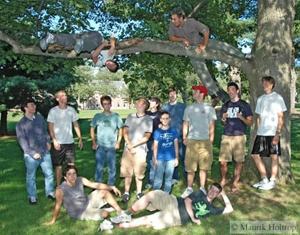
Welcome to the UNH Physics & Astronomy Department web pages!
We have tried to collect on this page some of this information that is probably most important to you as you decide on your major and your school.
Why come to the UNH Physics Department?
- We are a small department of about 20 faculty, 60 undergraduates and 60 graduate students.
- Being a small department, your upper division courses (second year and beyond) will typically have 20 or fewer students.
- There are many opportunities for undergraduates to do research at UNH. Students havebegun research as early as their freshman year here.
- We offer interdisciplinary options in material science, chemical physics, and astronomy.
- We offer an innovative first year course that teaches calculus and physics together. In this class, many of the activities involve group work and hands-on work.
- We have an active chapter of the Society of Physics Students which does service activities and enrichment activities.
For prospective majors & minors
Overview of physics research at UNH
How can you incorporate physics into your undergraduate career?
There are several different ways of incorporating physics into your undergraduate career. Below is an overview of all the programs and links to detailed plans of study for each.
In general, a physics education can help you learn how to solve large, complex problems. Our alumni agree. A background in physics is essential for graduate work in physics or teaching physics at any level, but is also a good preparation for pre-med students, engineering graduate work, and many technical positions in industry. If you are interested in teaching physics at the high school or middle school level, you will need to take both physics and education courses.
Note that all programs require students to complete UNH general education education and writing intensive requirements in addition to the physics requirements given below.
You may combine study in physics with study in another program by either minoring in one subject, or by having two majors. Consult the catalog for the details on second majors and minors. Also, see details below for unique programs that combine physics with mathematics, biology or chemistry.
You may incorporate physics in your undergraduate program in the following ways:
- B.S. in physics prepares students for professional work as a physicist, and is the first step to graduate work in physics. This is the most rigorous and rigid of the programs that we offer.
- B.A. in physics provides an opportunity for a broad and liberal education, which in some cases may be sufficient for graduate work. This program is also an excellent preparation for anyone wishing to teach physics at the middle or high school level. Because there are many fewer required courses than for a B.S., you have to time to pursue other academic interests.
- B.S. in engineering physics provides training for individuals who either seek employment in an engineering discipline that requires a deeper knowledge of physical principles or who intend to pursue a graduate degree in engineering. A BSEP degree differs from a traditional engineering degree in that the curriculum includes more of a focus on fundamental physics.
- Minor in physics includes 5 courses in physics, and allows students to become more deeply involved in physics without the commitment of a major.
- Interdisciplinary Math/Physics is administered by the mathematics department and is a mathematics degree. It allows a student to have a concentration in both mathematics and physics.
- Courses in Physics are open to all students with the appropriate background. Physics 401/402 and Physics 406 (Astronomy) are appropriate for the general student.